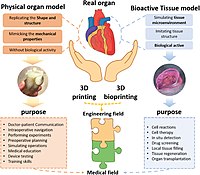
Photo from wikipedia
Bioprinting has attracted increasing attention in the tissue engineering field and has been touted to potentially become the leading technology to fabricate, and regenerate, tissues and organs. Bioprinting is derived… Click to show full abstract
Bioprinting has attracted increasing attention in the tissue engineering field and has been touted to potentially become the leading technology to fabricate, and regenerate, tissues and organs. Bioprinting is derived from well-known additive manufacturing (AM) technology, which features layered deposition of materials into complex three-dimensional geometries that are difficult to fabricate using conventional manufacturing methods. Unlike the conventional thermoplastics used in desktop, AM bioprinting uses cell-laden hydrogel materials, also known as bioinks, to construct complex living biological model systems. Inkjet, stereolithography, laser-induced forward transfer, and extrusion are the four main methods in bioprinting, with extrusion being the most commonly used. In extrusion-based bioprinting, soft materials are loaded into the cartridges and extruded from the nozzle via pneumatic or mechanical actuation. Multiple materials can be printed into the same structure resulting in heterogeneous models. In this focused review, we first review the different methods to describe the physical mechanisms of the extrusion process, followed by the commonly employed bioprintable soft materials with their mechanical and biochemical properties and finally reviewing the up-to-date heterogeneous in vitro models afforded via bioprinting.
Journal Title: Applied Physics Reviews
Year Published: 2019
Link to full text (if available)
Share on Social Media: Sign Up to like & get
recommendations!